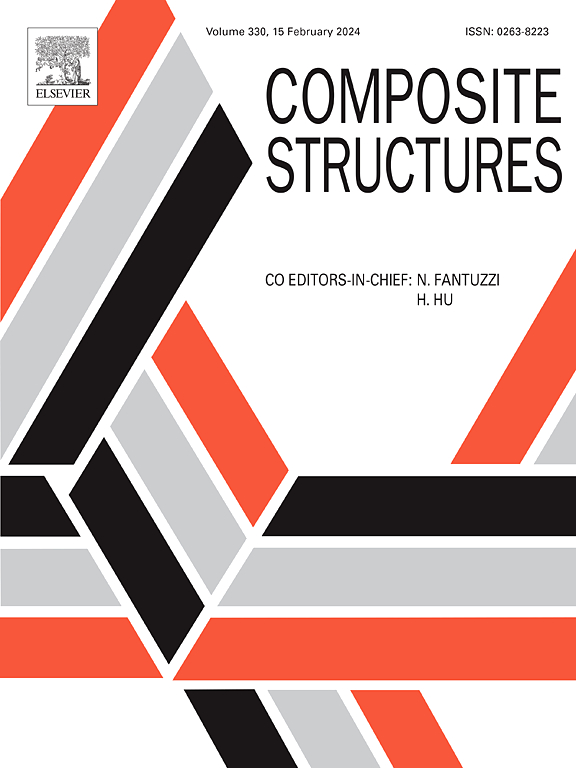基于x射线计算机断层扫描和声发射技术的SiO2f/SiO2陶瓷基复合材料拉伸损伤定量评价
IF 7.1
2区 材料科学
Q1 MATERIALS SCIENCE, COMPOSITES
引用次数: 0
摘要
陶瓷基复合材料(cmc)以其优异的耐高温性能而闻名。然而,由于其固有的脆性和可变性,大规模应用受到限制,这些挑战通过应用损伤监测方法来解决。目前的研究主要集中在定性损伤诊断上,缺乏对高温条件下损伤演变的定量评估。在本研究中,采用x射线计算机断层扫描(X-CT)、数字图像相关和声发射(AE)技术系统地分析了SiO2f/SiO2复合材料在不同温度下的拉伸行为。首先,利用X-CT对材料缺陷进行识别和分割,建立初始状态评估模型,实现对卸载状态下损伤的精确量化,从而识别出潜在的断裂风险区域。复合材料的拉伸性能受高达800℃高温的影响最小,在室温和高温下都具有脆性断裂特征。为了实时监测和量化加载过程中损伤的累积和演变,建立了基于ae的过程损伤评估模型。最终,建立了X-CT、声发射技术和机器学习算法相结合的集成模型,将缺陷的时空特征映射到损伤程度,为实时损伤评估和性能预测提供了一种新的方法。这项工作填补了cmc定量损伤评估的关键空白,为材料的实时健康监测和未来应用奠定了坚实的理论和技术基础。本文章由计算机程序翻译,如有差异,请以英文原文为准。
Quantification evaluation of tensile damage in SiO2f/SiO2 ceramic matrix composites based on X-ray computed tomography and acoustic emission techniques
Ceramic matrix composites (CMCs) are highly known for their exceptional high-temperature resistance. However, the large-scale application has been limited by their inherent brittleness and variability, with these challenges being addressed through the application of damage monitoring methods. Current research primarily focuses on qualitative damage diagnosis, with a notable lack of quantitative assessments of damage evolution under high-temperature conditions. In this study, X-ray computed tomography (X-CT), digital image correlation, and acoustic emission (AE) technologies were employed to systematically analyze the tensile behavior of SiO2f/SiO2 composites across different temperatures. Initially, X-CT was utilized to identify and segment material defects, and an initial state assessment model was established to achieve accurate quantification of damage in the unloaded state, thereby identifying potential fracture risk areas. The tensile properties of the composites are minimally affected by high temperatures up to 800 °C, with brittle fracture characteristics observed at both room and elevated temperatures. An AE-based process damage assessment model was developed to monitor and quantify damage accumulation and evolution in real-time during the loading process. Ultimately, an integrated model combining X-CT, AE technology, and machine learning algorithms was developed to map the spatiotemporal characteristics of defects to damage degree, providing a novel approach for real-time damage evaluation and performance prediction. This work fills a critical gap in the quantitative damage assessment of CMCs and establishes a robust theoretical and technical foundation for real-time health monitoring and future applications of the materials.
求助全文
通过发布文献求助,成功后即可免费获取论文全文。
去求助
来源期刊

Composite Structures
工程技术-材料科学:复合
CiteScore
12.00
自引率
12.70%
发文量
1246
审稿时长
78 days
期刊介绍:
The past few decades have seen outstanding advances in the use of composite materials in structural applications. There can be little doubt that, within engineering circles, composites have revolutionised traditional design concepts and made possible an unparalleled range of new and exciting possibilities as viable materials for construction. Composite Structures, an International Journal, disseminates knowledge between users, manufacturers, designers and researchers involved in structures or structural components manufactured using composite materials.
The journal publishes papers which contribute to knowledge in the use of composite materials in engineering structures. Papers deal with design, research and development studies, experimental investigations, theoretical analysis and fabrication techniques relevant to the application of composites in load-bearing components for assemblies, ranging from individual components such as plates and shells to complete composite structures.
 求助内容:
求助内容: 应助结果提醒方式:
应助结果提醒方式:


